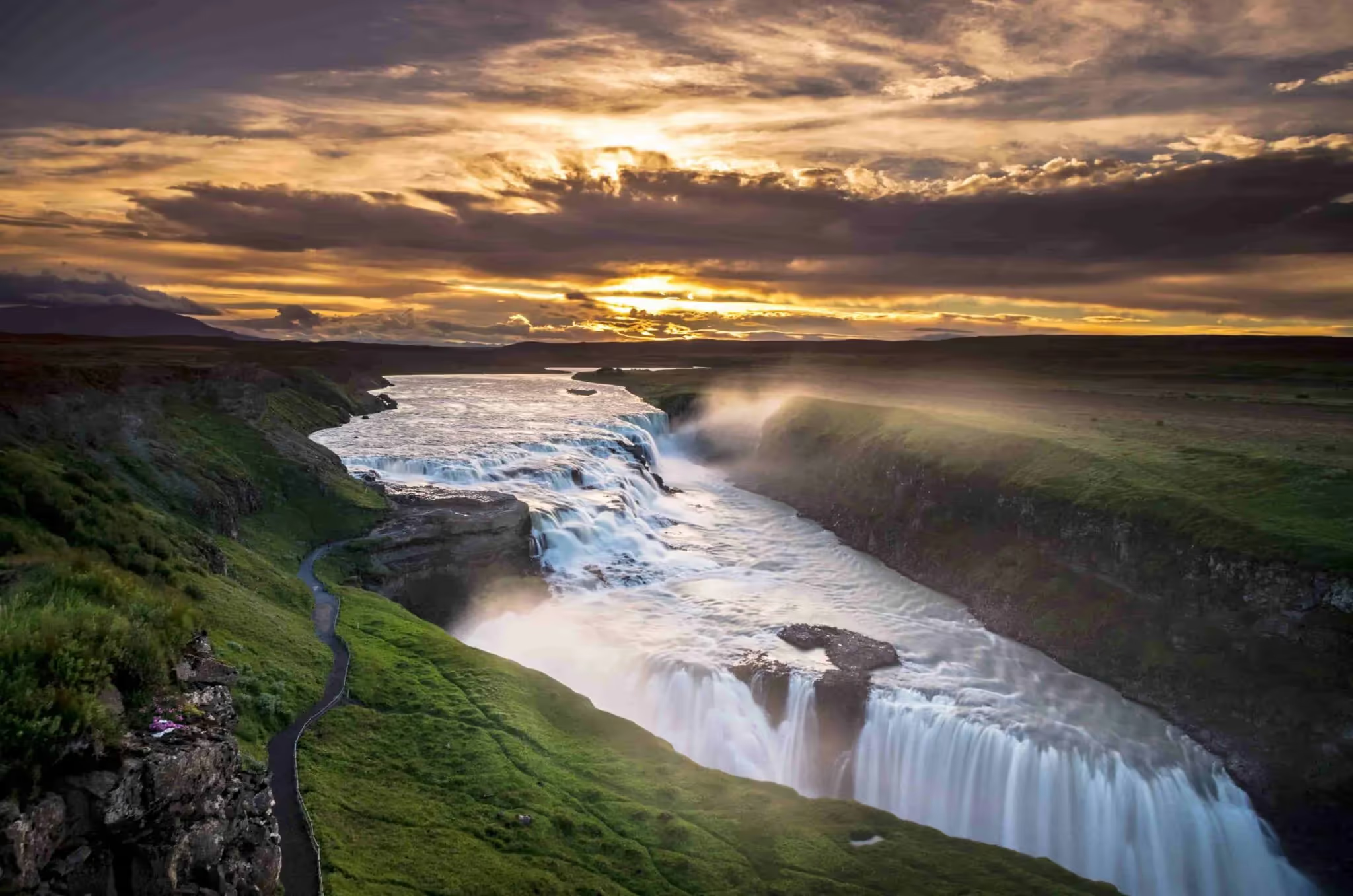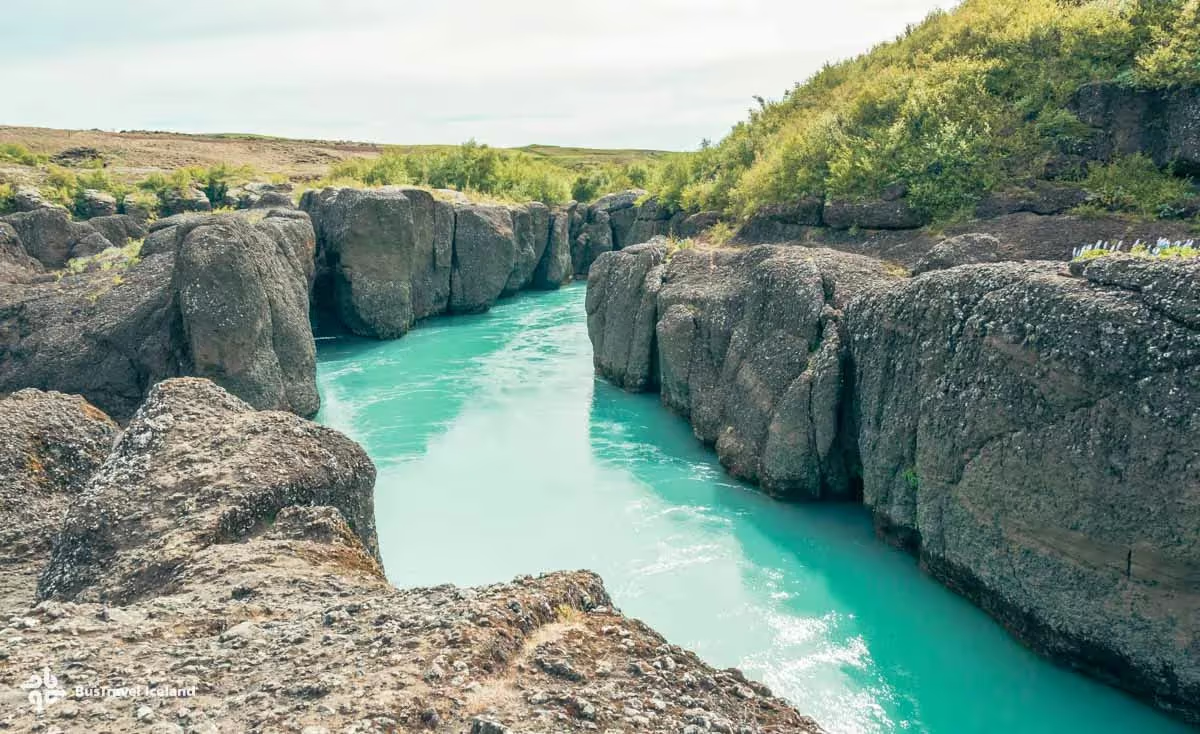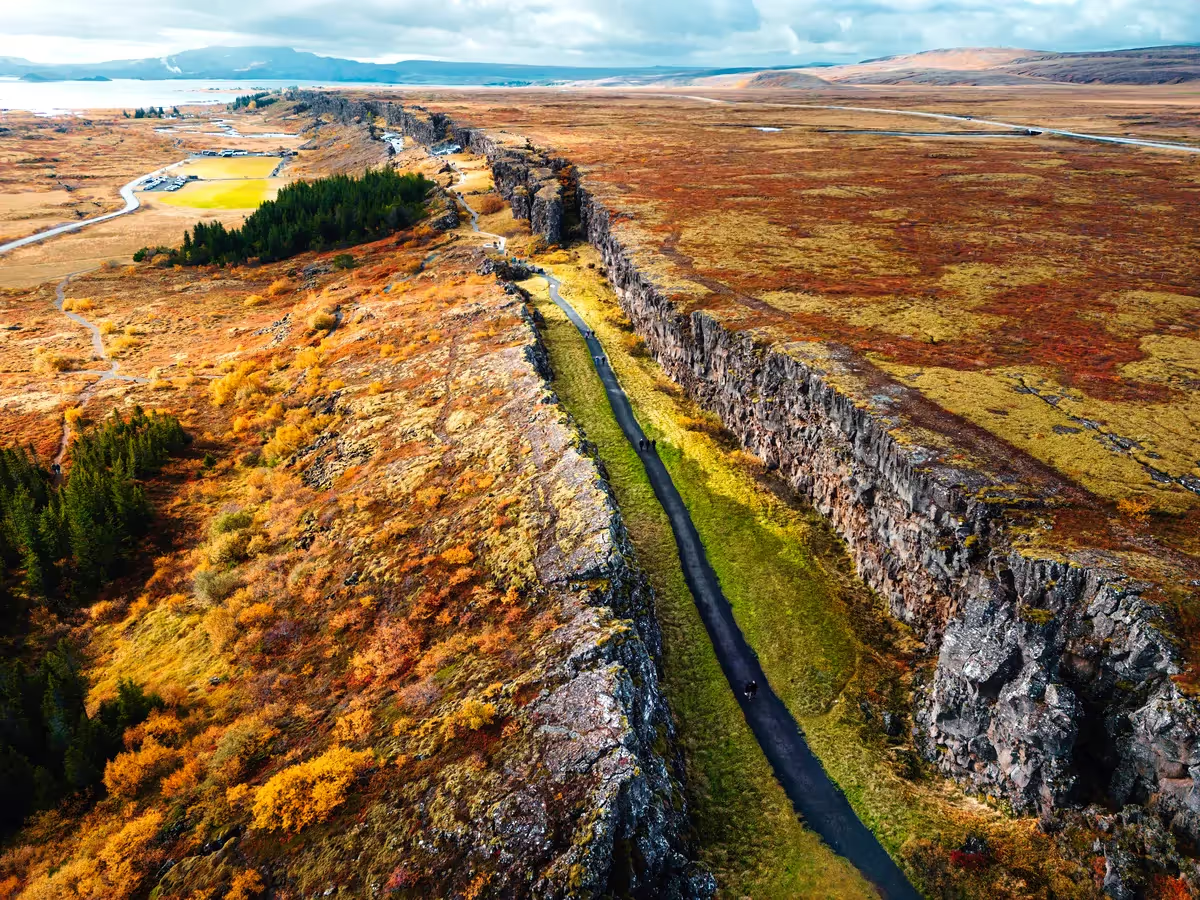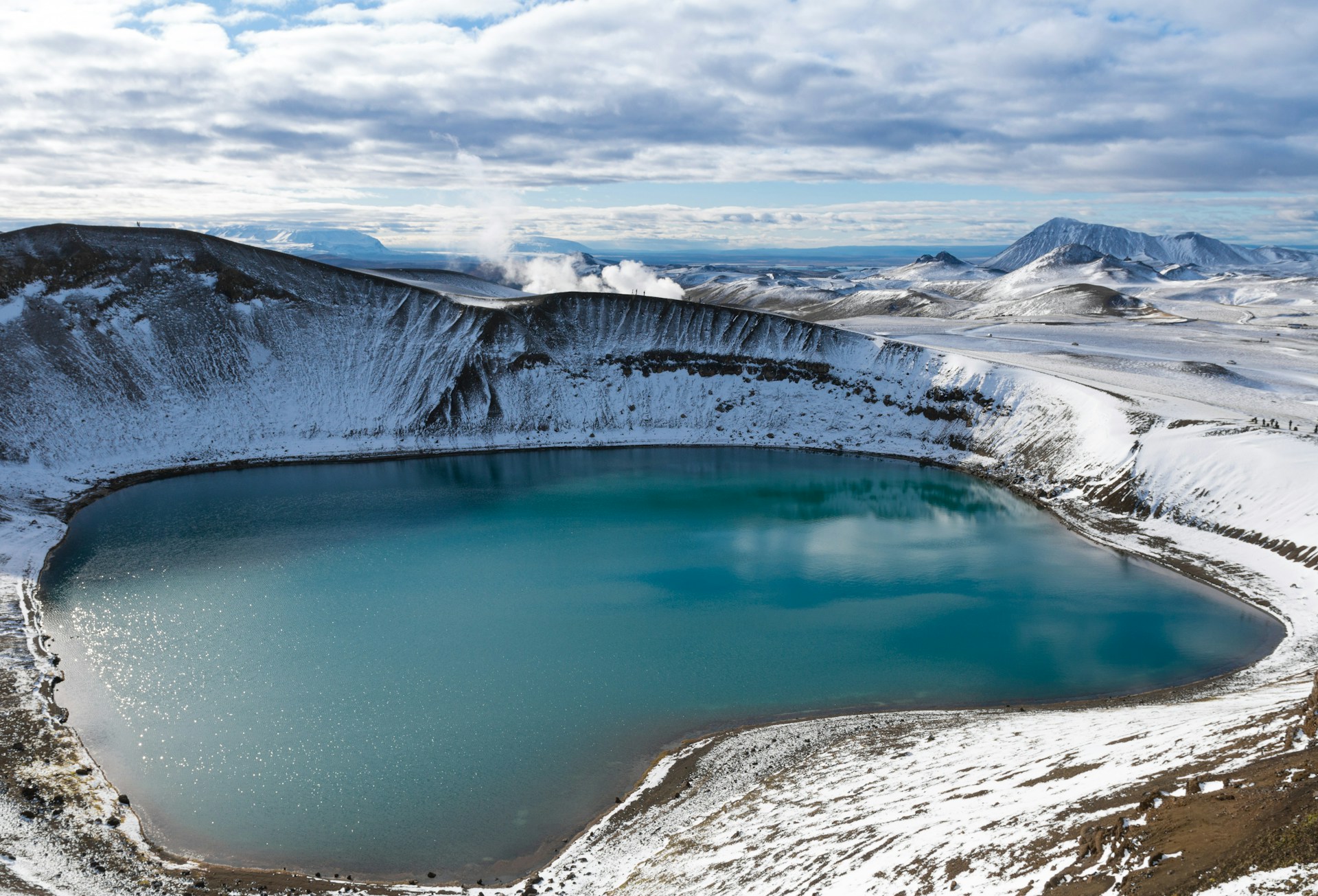Gullfoss Waterfall is one of Iceland’s most breathtaking waterfalls, known for its powerful cascades and dramatic scenery. Its raw beauty, combined with the surrounding landscapes, makes it a must-visit destination on the Golden Circle.
Whether you're visiting in summer when the water flows at its peak or in winter when the falls are surrounded by ice, Gullfoss offers a unique experience in every season. This guide provides essential tips to help you make the most of your visit.
What Is Gullfoss?
Gullfoss, or "Golden Falls," is a breathtaking waterfall known for its powerful cascades and frequent rainbows on sunny days. In the early 20th century, Sigríður Tómasdóttir helped protect it from hydroelectric development.
Open year-round and free to visit, it remains a must-see for nature lovers and photographers.
Where Is Gullfoss Waterfall Located?

Gullfoss Waterfall is located in southwest Iceland, within the Hvítá River canyon in the Bláskógabyggð municipality. It is a key highlight of the Golden Circle, Iceland’s most famous tourist route, which also includes the Geysir Geothermal Area and Þingvellir National Park.
13 Things to Know Before Visiting Gullfoss Waterfall
1. Gullfoss Waterfall Facts
Gullfoss is a powerful display of nature where the Hvítá River dramatically drops in two major stages through a rugged canyon. The waterfall's first descent is 11 meters, followed by a larger 21-meter drop, totaling a 32-meter fall into a deep, 20-meter wide crevice.
This tiered arrangement and the forceful plunge into the crevice make Gullfoss a stunning spectacle, drawing visitors from around the globe for its breathtaking views. The vast width of the river and its descent through natural "staircases" contribute to the waterfall's grandeur and scenic beauty.
2. The Origin of Gullfoss Waterfall's Name
Gullfoss, meaning "Golden Falls," derives its name from the golden mist that often rises above the cascade on sunny days. This mist, enriched with sediments from the Langjökull glacier, reflects sunlight, creating a stunning visual effect that has inspired the waterfall's name.
The term "Golden Falls" captures the magical interplay of light and water, making Gullfoss a symbolic natural wonder within Iceland. The beauty of this phenomenon makes Gullfoss not only a powerful natural site but also a poetic symbol of Iceland's natural beauty.
3. Source of Gullfoss Waterfall's Hvítá River
The Hvítá River, powering Gullfoss, originates from Hvítárvatn, a glacial lake at Langjökull, Iceland's second-largest glacier. This river is fed by the meltwaters of Langjökull, ensuring a voluminous and swift flow essential for the waterfall's formidable force.
As the river flows towards Gullfoss, it gathers both speed and volume, culminating in the spectacular display at the falls. The river's glacial origins are crucial in maintaining the dynamic and voluminous nature of Gullfoss, creating varying visual spectacles depending on the season and glacial melt rates.
This constant change enriches the visitor experience, offering a unique spectacle with each visit as the shifting waters reflect different aspects of Iceland's natural beauty and power.
4. Path of the Hvítá River: From Gullfoss to the Atlantic

After cascading down the dramatic heights of Gullfoss, the Hvítá River embarks on a meandering journey towards the Atlantic Ocean. Along the way, it is joined by three significant tributaries—Tungufljót, Brúará, and Stóra Laxá—each contributing to its volume and enhancing the river's vigor.
As it approaches the area near Þrastarlundur, it merges with the Sog River, at which point it is renamed Ölfusá. This river, now bearing a new identity, flows through the town of Selfoss, continuing its path until it reaches the ocean between Eyrarbakki and Þórlákshöfn, closer to Eyrarbakki.
The journey can be witnessed from the bridge on Road 34, offering a scenic view of where the river finally meets the Atlantic.
5. How Was Gullfoss Formed?
The Gullfoss Canyon, where the Gullfoss Waterfall dramatically descends, was sculpted by a powerful geological event known as a jökulhlaup—an immense glacial flood. This type of flood occurs when volcanic activity beneath a glacier, like Langjökull, triggers the rapid melting of ice, resulting in a massive outflow of water.
The force of these floods is so great that they carve out substantial chasms from solid rock, shaping the steep and rugged terrain that characterizes the canyon today. This process illustrates the dynamic interaction between Iceland's volcanic activity and its glacial landscapes, continually reshaping the earth with spectacular results.
6. Gullfoss Waterfall's Rank Among Iceland's Largest
Despite its moderate height, Gullfoss ranks as one of Iceland's largest waterfalls by volume, second only to Dettifoss in the north. The average water flow at Gullfoss during summer is approximately 4,900 cubic feet per second, showcasing its immense power.
However, during periods of heavy melt or rain, the flow can surge dramatically, with the highest recorded rate reaching up to 71,000 cubic feet per second. This substantial flow makes Gullfoss not only a beautiful sight but also a significant natural phenomenon in Iceland's landscape.
7. The Battle to Save Gullfoss
In the early 20th century, a proposal emerged to dam the Hvítá River upstream from Gullfoss to utilize its potential for hydroelectric power, which threatened the existence of the Iceland waterfall Gullfoss. Sigríður Tómasdóttir, a dedicated local environmentalist and farmer’s daughter, became a pivotal figure in opposing these plans.
She actively campaigned against the dam, often traveling to Reykjavík to advocate for the preservation of Gullfoss, and succeeded in influencing legislation to restrict foreign investment in the project. Her efforts are commemorated by a stone statue and plaque at the site.
Following years of debate and changing leadership, Gullfoss was granted permanent protected status in 1979, securing its future as one of Iceland's most cherished natural landmarks.
8. When Is Gullfoss Open?
Gullfoss is accessible every day throughout the year. During the winter months, the lower pathways are closed due to icy conditions, although the views from the upper areas remain spectacular. These upper pathways and viewpoints are also wheelchair accessible, ensuring that visitors of all mobility levels can enjoy the breathtaking scenery.
9. Facilities and Dining Options Near Gullfoss Waterfall
When visiting Gullfoss Waterfall, you’ll find convenient dining options that offer warm meals and refreshments, perfect for recharging after exploring the falls.
Facilities and Gift Shop
At Gullfoss, there is a small fee for using the toilets at the car park, but customers dining at the Panorama Restaurant, Café, and Gift Shop can access the restrooms free of charge. The gift shop, located within the café, offers an array of Icelandic souvenirs, including jewelry, books, local foods, and clothing, making it an excellent place to pick up a keepsake from your visit.
Gullfoss Café and Panorama Restaurant
The Gullfoss Café and Panorama Restaurant, located near the main viewing area, serve a variety of traditional and modern Icelandic dishes. A visitor favorite is kjötsúpa, the classic Icelandic lamb soup known for its rich and hearty flavors.
Vegan soups, fresh salads, sandwiches, and homemade cakes are also available, catering to different dietary preferences. Alongside these meals, you can enjoy a selection of beverages, including coffee, soft drinks, and Icelandic beers.
10. Things to Do in Gullfoss Waterfall
Visiting Gullfoss Waterfall offers a variety of activities that allow visitors to experience the beauty and power of one of Iceland's most famous natural wonders. Here are some things to do at Gullfoss Waterfall:
- Viewing the Falls: The primary attraction at Gullfoss is the waterfall itself. There are several viewing platforms that provide spectacular views of the falls from different angles. The upper deck offers panoramic views, while the lower paths, open in the summer, allow visitors to get closer to the roaring water.
- Hiking and Walking: Surrounding Gullfoss are several hiking trails that visitors can explore. These trails offer scenic views of the river and the surrounding landscape. The terrain is varied, providing options for both casual walkers and more serious hikers.
- Photography: With its dramatic views and natural beauty, Gullfoss is a paradise for photographers. Whether you're an amateur with a smartphone or a professional with a DSLR, the changing water flow, light, and mist create dynamic and diverse photo opportunities.
- Visit the Gullfoss Cafe: After exploring the falls, you can visit the nearby Gullfoss Cafe. The cafe offers a range of refreshments and meals, including the traditional Icelandic soup, making it a perfect spot to relax and enjoy the local cuisine.
- Shopping for Souvenirs: The gift shop at Gullfoss sells a variety of souvenirs, from local handicrafts to books and apparel. It's a great place to find unique gifts and mementos for your visit.
- Seasonal Activities: Depending on the season of your visit, Gullfoss offers different experiences. During Gullfoss waterfall winter is surrounded by ice and snow, creating a stunning frozen landscape. Summer provides lush greenery and fuller water flow.
- Guided Tours: Many visitors choose to explore Gullfoss as part of a guided tour, often within the Golden Circle. These tours not only provide transport and insights into the waterfall's history and geology but also often include stops at other nearby attractions like the Geysir geothermal area and Þingvellir National Park.
11. Distance from Gullfoss to Geysir and Þingvellir
Gullfoss is located just 10 km (6 miles) from the Geysir Geothermal Area, making it an easy 10- to 15-minute drive along Road 35. For those heading to Þingvellir National Park, the shortest route spans 70 km (43 miles) via Roads 35, 365, and 37, typically taking about 1 hour by car.
An alternative, slightly longer route through Skálholt covers 80 km (50 miles) along Roads 35, 358, 35, 37, and 365 from Laugarvatn, offering a scenic drive through the historic Icelandic countryside.
12. How To Get To Gullfoss Waterfall from Reykjavík
By Car (Self-Drive or Car Rental)
Driving from Reykjavík to Gullfoss generally takes about 1.5 to 2 hours, depending on traffic and weather conditions. Renting a car or driving your own vehicle provides the flexibility to explore at your own pace.
The route via Route 35 is scenic, offering views of Iceland's dramatic landscapes and allowing stops at other Golden Circle attractions like Þingvellir and the Geysir area. This option is perfect for those who value independence and wish to immerse themselves in Iceland’s natural beauty.
By Bus
Traveling by bus from Reykjavík to Gullfoss can take approximately 2 to 2.5 hours. Buses typically depart from major stations such as the BSI Bus Terminal and provide a direct route to Gullfoss. This option is cost-effective and allows travelers to relax and enjoy the scenery without the hassle of driving.
By Guided Tour
Guided tours to Gullfoss are usually part of a larger Golden Circle tour, which might also include Þingvellir National Park and the Geysir geothermal area. Depending on the itinerary, these tours can last from a half-day to a full day.
13. Best Places to Visit Near Gullfoss Waterfall
Gullfoss is one of Iceland’s most famous waterfalls, but the surrounding area is packed with equally stunning natural wonders and historical sites. Here are five must-visit attractions near Gullfoss that you should add to your itinerary.
Geysir Geothermal Area (10 km / 6 miles from Gullfoss)
Just a short drive from Gullfoss, the Geysir Geothermal Area is home to Strokkur, Iceland’s most active geyser, which erupts every 5 to 10 minutes, shooting boiling water up to 20 meters (65 feet) into the air. The area is dotted with bubbling hot springs, steaming vents, and mineral-rich pools, offering a unique glimpse into Iceland’s geothermal activity.
Þingvellir National Park (70 km / 43 miles from Gullfoss)

A UNESCO World Heritage Site, Þingvellir (Thingvellir) National Park is a historic and geological marvel. It was the site of Iceland’s first parliament, founded in 930 AD, and is where the Eurasian and North American tectonic plates meet, creating dramatic rifts and fissures.
Visitors can walk through Almannagjá Gorge, snorkel in the crystal-clear waters of Silfra Fissure, and explore the park’s lava fields and waterfalls.
Secret Lagoon (30 km / 19 miles from Gullfoss)
For a relaxing experience, visit Secret Lagoon (Gamla Laugin), one of Iceland’s oldest natural hot springs. Located near the town of Flúðir, this geothermal pool offers warm, mineral-rich waters that hover around 38-40°C (100-104°F) year-round. Surrounded by steaming vents and moss-covered landscapes, it's a quieter alternative to the more famous Blue Lagoon.
Kerið Crater (55 km / 34 miles from Gullfoss)
The Kerið Crater is a striking volcanic caldera filled with vibrant blue water, contrasting beautifully against its red volcanic rock walls. This crater, approximately 3,000 years old, offers a short hike around its rim and a trail leading down to the water’s edge. It’s a quick but worthwhile stop for anyone exploring the Golden Circle.
Langjökull Glacier (Accessible via tours from Gullfoss)
As Iceland’s second-largest glacier, Langjökull is a must-visit for adventure seekers. Several tours depart from Gullfoss, offering activities like glacier snowmobiling, ice cave exploration, and even walking inside man-made ice tunnels. The views from the glacier are breathtaking, providing a unique perspective on Iceland’s icy landscapes.
Tips for Visiting Majestic Gullfoss Waterfall

Visiting Gullfoss is unforgettable, and these tips will help you enjoy the best views, stay safe, and avoid crowds:
- Gullfoss is busiest from late morning to early afternoon. Arriving early or later in the evening provides a quieter experience and better photography lighting.
- The area can be cold, windy, and wet. Wear waterproof and windproof clothing, sturdy hiking boots, and layer up for changing temperatures.
- Icelandic weather can change rapidly, and roads to Gullfoss waterfall lookout may be affected by snow, ice, or strong winds, especially in winter. Stay updated on current conditions to ensure a safe and smooth journey.
- The mist from the falls makes paths slippery. Always follow safety barriers and avoid getting too close to the edge.
- A café and gift shop are available near the falls. Public restrooms require a small fee unless you're dining at the café.
- Winter roads can be icy and dangerous. Renting a 4x4 or booking a tour ensures a safer journey.
Ready for the Adventure?
Visiting Gullfoss offers a profound connection to Iceland’s natural beauty and environmental history. It's an experience that resonates with all who witness its grandeur. For the best experience, consider booking your tour with Golden Circle Day Tours to ensure a memorable visit filled with expert guidance and breathtaking views.




